The need for space-quality instrumentation for the James Webb Space Telescope has resulted in innovative detectors that will benefit many ground-based efforts well before the telescope's launch.
Hank Hogan, Contributing Editor
From the middle of the Pacific, Gerard Luppino has a good view of the future and of the past. Luppino, an astronomy professor at the University of Hawaii’s Institute of Astronomy in Honolulu, has access to the optical and infrared observatories clustered on the 13,800-foot summit of the dormant volcano Mauna Kea. Those instruments allow him to probe deep into the past.
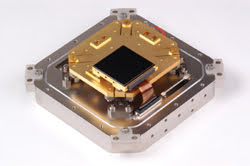
Researchers at Lincoln Laboratory at Massachusetts Institute of Technology built the eight 2k × 4k-pixel CCDs that make up this 8k × 8k optical CCD mosaic. The pixel size is 15 μm, and the overall array measures 122 mm2. GL Scientific designed and built the mosaic in 1999 for the Mount Stromlo Observatory near Canberra, Australia.
He also runs GL Scientific in Honolulu, an essentially one-man show that helps design large CCD mosaics. These sensor clusters circumvent commercial detector area limitations and are challenging to build. He noted that designing infrared and visible CCD mosaics keeps the company occupied for now. “I’m not hurting for business,” he said.
Advanced infrared sensors are at the heart of the James Webb Space Telescope (JWST), an $825 million orbiting infrared observatory that is planned for launch in 2011. So Luppino can see the future, at least as far as astronomers and detectors are concerned. “There are telescopes that can deliver large wide-field infrared images, and they want the detectors that can suck up those photons,” he said.
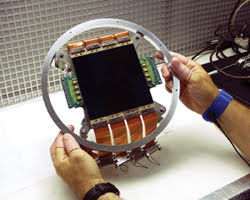
This partially populated mosaic being built for the Canada-France-Hawaii Telescope is the same device that will be used on the James Webb Space Telescope. The module will have four 2k × 2k H2RG detectors from Rockwell Scientific.
Fortunately for practitioners of one of the oldest sciences, advances in technology mean that these wishes won’t go unfulfilled. Although developed for the Webb telescope, these new infrared detectors are also finding a home in ground-based telescopes.
Seeing back in time
The demands of the space telescope forced and funded some detector innovations. A successor to the Hubble Space Telescope, it will focus on the formation of the first stars and galaxies. Thus, it will look at a time when the universe was between a million and a few billion years old.
Because the light from these objects has been greatly redshifted, the telescope’s instruments are designed to capture photons from 0.6 to 28 μm. The goal is for greater than 90 percent quantum efficiency for the important 1- to 5-μm range. The telescope will scan this spectrum with the spatial resolution of the Hubble and at 400 times the sensitivity of current instruments.
In developing detectors for the 0.6- to 5-μm near-infrared region, NASA funded two parallel efforts, both of which involved an academic group working with a commercial firm. One team came from the University of Rochester in New York and from Raytheon Co. of Waltham, Mass. This group made sensors out of commercial integrated circuits and indium-antimonide photodiodes.
“In general, the way it worked was the corporation produced the detector arrays and then the university tested them to verify that they met requirements,” said Craig McMurtry, a senior research engineer at the university. He noted that an independent testing group at the Space Telescope Science Institute in Baltimore also tested both detector candidates.
The second team was from the University of Hawaii and from Rockwell Scientific Co. LLC of Thousand Oaks, Calif., with Donald Hall, a professor at the university, serving as technical lead. Rockwell’s detector used mercury cadmium telluride and was the one selected in late 2003 by NASA for the NIRCam and NIRSpec near-infrared instruments for the Webb telescope. This was done for several reasons, according to Luppino: “Readout noise, dark current and quantum efficiency are three main things. These devices have such low dark current that they help solve some systems problems in the telescope.”
The low dark current means that the devices can meet specifications at close to 40 K, or 40° above absolute zero, which makes the design of the telescope easier because the detectors don’t have to be protected as much from the heat produced by the rest of the system. The Rockwell parts allow the telescope to operate at as high as 40 K without performance degradation.
This is a real benefit because making these detectors is a challenge. They consist of arrays of hybrid chips, each of which has 2k × 2k pixels approximately 18 μm in size. An integrated circuit on half of the hybrid measures 40 mm on a side and is built using an advanced CMOS process. This supplies the circuitry for the detector.
McMurtry noted that building these devices is tough and that the Rochester-Raytheon team got only a few good die per silicon wafer. Part of the problem was the size of the device, which has 4 million pixels; part was the requirement that it function at a low temperature; and the final element was the interaction of the chip with the other detector components. All of this added up to lower yield than might have been the previous case. “To meet the requirements of the JWST, we tend to have to screen detector arrays much more stringently than has been done in the past,” he said.
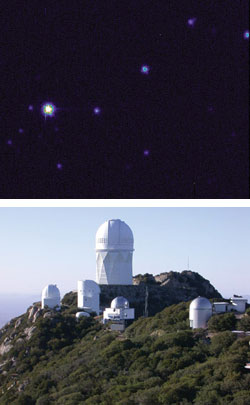
The Cascade on-chip multiplication-gain camera on the 4-m Mayall telescope (bottom) at Kitt Peak National Observatory near Tucson, Ariz., captured this image (top) of the M-92 globular cluster. Courtesy of Roger Lynds and Dave Mills.
To build the detector, the integrated circuit chip is bonded via a conducting indium bump to a photodiode array, with one photodiode and bump per pixel. There are 4 million or so bumps, and each requires about a gram of pressure to successfully hybridize the photodiode array to the Si readout. So it takes 4 million grams, or about four metric tons, of pressure to successfully bump-mate these parts, and this requires specialized equipment, which each vendor has produced for this application.
Building mosaics
At that point, Luppino added, the real fun starts. The upper limit on detector size for a hybrid chip is determined by the yield of the integrated circuit and the difficulty in creating the hybrid. However, that limit is today too small for the Webb telescope, and a bigger detector has to be created by clustering chips together in an array. On the telescope’s near-infrared system, eight chips are to be used in two groups of four in two-by-two arrays, and another two chips are to be used independently. The various groupings are optimized for different wavelengths and resolutions through the use of filters and the like.
This clustering can’t be accomplished simply by placing the chips alongside each other. For these mosaics to work, the detection area has to run to the edge of the chip.
“We’re trying to make these parts edge-buttable on at least three of the four edges so you can create close-packed mosaics and minimize the gap sizes. And that had never been considered before for these devices,” Luppino said.
This has been done for optical CCDs for more than a decade. Luppino was a pioneer in this area. One of the tricks is to eliminate bonding pads along the chip edge. Such pads are used to connect chips to the outside world, but they’re hundreds of microns in size, which means hundreds of microns of no detection area. Even by getting rid of bonding pads, it’s not possible to reduce the gap below a few millimeters. That, however, is good enough for this application.
With a mosaic, the gap is accounted for by taking an image, reading it out and moving the telescope’s line of sight slightly. Repeating this process allows the missing pixels to be filled in.
Luppino noted that spaceborne-device mosaics are actually a bit easier to build than their Earthbound cousins because those that stay on the ground have to work in gravity and are subject to flexing and stress. On the other hand, he added, for those going into the space telescope, “You do have to worry that the thing survives launch.”
In the case of the new space telescope, this concern about continued functionality extends over the entire five- to 10-year duration of the mission. That’s because the telescope won’t orbit Earth but, instead, pace the planet around the sun. It will sit at a distance of about 1.5 million km (0.9 million miles) beyond Earth’s orbit in what is known as the second Lagrange point. Because of the competing gravity of the sun and Earth, the telescope can maintain a station there with little expenditure of fuel and without falling behind the planet. Thus, the alignment of the Earth, sun and telescope will remain constant.
The spot is far enough away that the sensitive infrared instruments won’t be swamped by light from Earth or the moon. However, because it is too far away for any kind of repair or access by a shuttle, the telescope will be on its own after launch.
Meanwhile, back on Earth
McMurtry noted that, even after a telescope launches, the instrument developers’ work isn’t over. The university is involved in another infrared telescope, the Spitzer Space Telescope. One innovation in this project, which launched in 2003, was large-format IR detector arrays. These aren’t as large or as capable as those that will be on the Webb telescope.
Besides working on getting data and processing it for the science side of the project, McMurtry and others are still tinkering with the detectors. They work with a terrestrial analog of the orbiting devices and look for ways to extend their capabilities. This is easier to do in a readily accessible lab. What’s more, tests can be performed on the ground that cannot be carried out in space on a working telescope. Such tests may not adhere to operating guidelines for the project. “Running certain detector tests on-orbit would violate time constraints or instrument operations,” McMurtry said.
Working with copies of the telescope’s detectors won’t be the only effect felt on the ground. Luppino listed a half dozen projects based on the new IR detectors. Many of these are ground-based and will see first light in the next few years. All of them will benefit from the technology, one that might not have been developed without the demands of space.
Given that the satellite costs close to $1 billion and can’t be repaired once launched, it made sense for NASA to spend millions of dollars and years in development on the sensors. That’s something that observatories can’t justify, so it’s doubtful that the devices would have been developed by any organization other than NASA.
“Had JWST not waltzed in, we wouldn’t have the detectors,” Luppino said. He added that, although that may be the case, NASA isn’t the only beneficiary of the detectors, and it isn’t even the main customer. “The primary customer right now for Rockwell for these parts isn’t satellites, it’s ground-based. All these big telescopes are buying these detectors up at half a million bucks a pop.”
Therefore, the first discoveries made possible by the sensors may come long before the space telescope sees first light.
On the Visible Front
While the James Webb Space Telescope has been spurring the interest in and development of infrared detectors, the optical variety hasn’t been standing still. The largest optical mosaics, for example, are 18k pixels on a side, and the gaps between the mosaic chips measure a few tens of pixels. Infrared sensors can’t match either of these figures.
Ravi Guntupalli, marketing manager for Trenton, N.J.-based Princeton Instruments, a division of Roper Scientific Inc., noted that optical and infrared detectors are alike in at least one way. In both, the mosaic detectors are constructed primarily by astronomers and other interested academics. There’s not enough commercial interest to justify the expense of building a mosaic.
However, there is commercial interest in optical sensors and cameras. Guntupalli pointed to a trend in astronomy markets: the need for speed. There’s an interest in more than full-resolution 30-fps video speeds. “Currently, people want to go much faster. They want to go at 100 fps,” he said.
The main reason for this is the desire to employ sensors in adaptive optics. By tracking the changes of a bright guide star, Earthbound astronomers can flex mirrors and optics in a telescope to compensate for the jitter induced by the atmosphere, resulting in clearer images of nearby stars, galaxies and other objects.
Achieving real-time compensation requires a fast-frame-rate camera and rapid access to the data in each frame for error computation. A more sensitive camera also allows fainter stars to be used as guides. The recent introduction of on-chip multiplication gain, an intensification technology, has allowed Roper to build faster-frame-rate cameras with higher sensitivity. That and the lack of burn-in of pixels have captured the interest of professional astronomers.
Even amateur astronomers, however, want faster cameras. Amateurs, like professionals, want to take the best possible images. What they don’t want to do is to have their systems devote more time than is necessary to anything else. Gary McAnally, vice president of marketing and sales at Apogee Instruments Inc. in Auburn, Calif., said, “Time spent waiting for cameras to read out is not time spent acquiring more data. The higher the pixel count, the more important this becomes.”
McAnally estimated that a system running at 5 MHz could snap an extra 100 images per night as compared with one reading out data at 1/10 the rate, or 500 kHz. Likewise, higher quantum efficiencies, which translate into shorter exposure times, could boost the number of images captured.
Because discoveries are a combination of luck and the area of sky that is searched, both of these advantages could mean the difference between being the first astronomer to spot a new comet or supernova and being one of those just reading about it.
Going for a Spin on Mars
When NASA’s martian rovers prowled about the red planet early this year, they did so partly thanks to filters supplied by Omega Optical Inc. of Brattleboro, Vt., for the rovers’ cameras. Those cameras and the associated instrumentation were used both for navigation on Mars’ surface and for scientific imaging.
At nearly the same time, NASA’s Stardust, a comet-chasing probe, passed within 150 miles of the comet Wild-2. The company also supplied filters for the probe’s optical system.
Calvin Grandy, an astronomy and aerospace products engineer at Omega Optical, said that the filters for this up-close astronomical research aren’t all that different from those found on the ground, but that specifications are tighter. “Everything’s documented, everything’s dictated, everything’s controlled, and everything’s built as specified,” he said.
The reason for these rigid constraints is that any deviations have a multiplicative effect. A change in filter thickness, for example, may lead to a new mass, which, in turn, may mean that motors have to be altered. In the end, there may be a new mass calculation.
Filters must hit their design targets for spectral performance to ensure that the instruments perform as intended. However, Grandy noted, they also have to stay within tight tolerances for size and be able to withstand the rigors of launch and of whatever environment they encounter.
On the ground, the challenge is to build filters that are large enough. As telescopes and detectors grow in size, one of the problems becomes building high-performance filters measuring 30 cm or so on a side. The trend is toward even larger instruments.
But Grandy, for one, accepts these challenges. “I don’t think anyone can read about the strides that astronomy has taken with the [Mars] landing [or look at] those beautiful images from the Hubble and not be just really impressed with the work that human beings can do.”
Look, Ma, No Astronomers!
Tim Puckett is a serious amateur astronomer. He runs his own observatory in the mountains of northern Georgia, complete with a 60-cm reflector telescope that took some 10,000 hours to build. Using this and other tools, Puckett studies comets and hunts for supernova. But that doesn’t mean he spends a lot of nights perched on a mountainside.
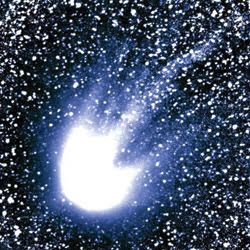
This photo of Hale-Bopp comet was obtained with a 30-cm reflector working at f/6. It is a 17-minute exposure taken with an Apogee AP-7 CCD. ©1997.
“I’m getting ready to start the supernova patrol,” he said on a May evening. “I’m about 90 miles away from the mountaintop where the telescope is.”
Puckett does all this using the power of the Internet. He has a series of scripts that he runs to direct the three computerized telescopes at the Puckett Observatory to the right location and to capture the data. At the end of the night, another script grabs all the images, compresses them and then downloads them for perusal. Some he looks at, and some he farms out to volunteers around the world. What they’re looking for are stars that appear in one image but not in the preceding one. Such sudden flashes could announce a supernova, the bright death throes of a large star.
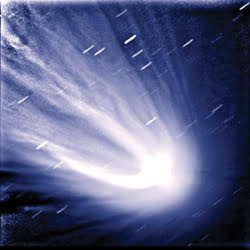
An LX200 reflector working at f/6 captured this false-color image of the Hale-Bopp comet. This is a composite of 50- to 15-second exposures taken with an Apogee AP-7 CCD. The images were enhanced to show the jets from the nucleus. ©1997.
Amateurs aren’t the only ones who are observing remotely. Professionals also are viewing the sky from their offices and desktops. They’re doing this not only for convenience, but also for efficiency. Ed Turner, a Princeton University professor and director of the Apache Point Observatory in Sunspot, N.M., noted that remote operation allows astronomers to share time. Observing can be done when a target object is particularly well-placed in the sky. Turner estimated that this increases the scientific effectiveness of a telescope-per-unit time by a factor of two.
One challenge that remote operations face is bandwidth. As instruments and detectors improve, data rates are expected to increase by a factor of 10 or 100 over the next few years. This means that more data will be generated and more images will have to be moved. The solution, according to Turner, is to use higher-capacity networks, such as Internet2, as they become available.